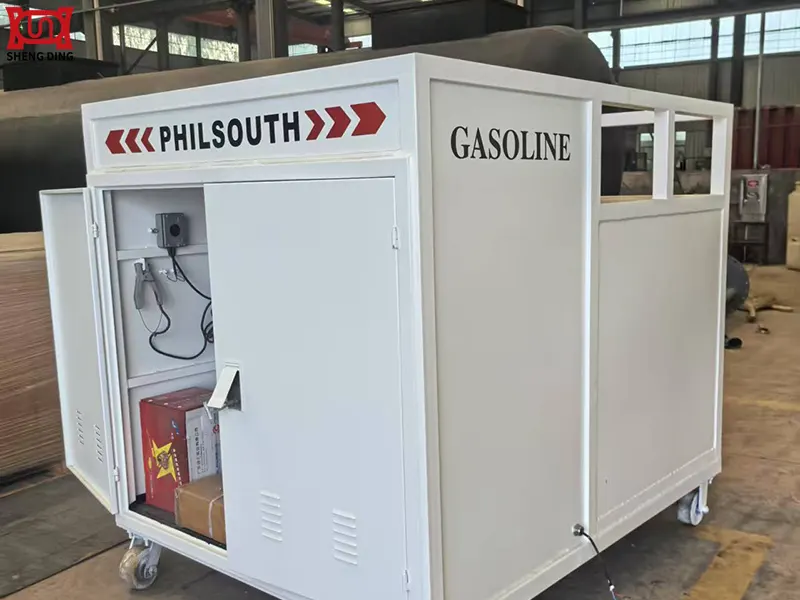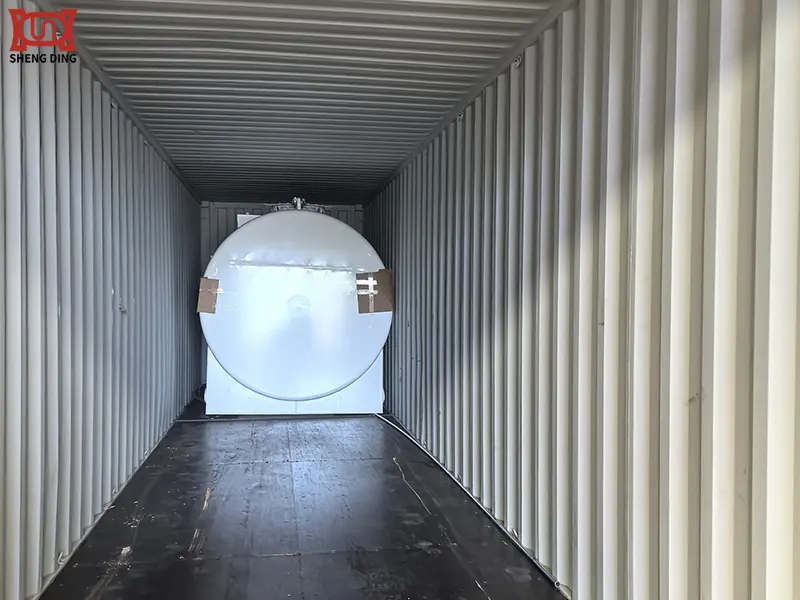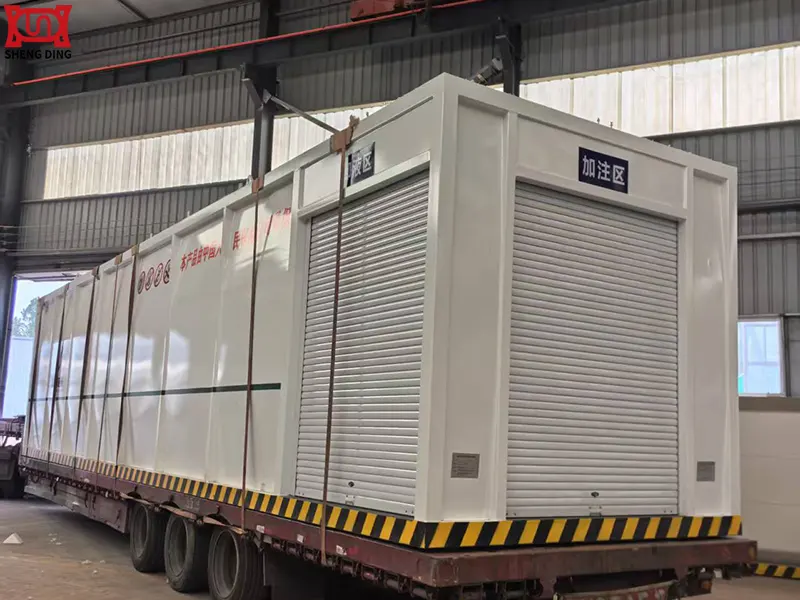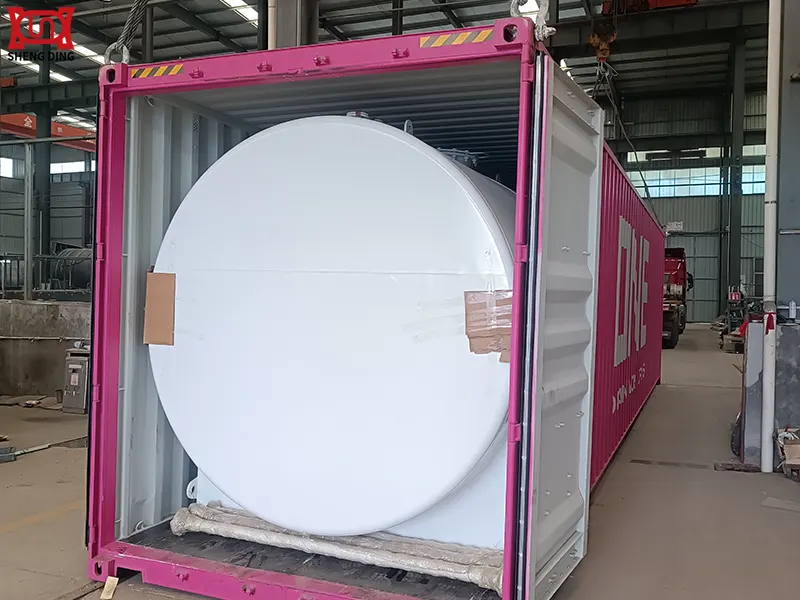Research on the structural design and safety performance of double-layer tanks for skid-mounted refueling equipment
I. Overview of Skid-Mounted Fueling Stations and Double-Walled Tanks
A skid-mounted fuel station (abbreviated as a "skid-mounted station") is a modular fueling system that integrates fuel storage, filling, and security monitoring functions within a movable steel frame. It is widely used for temporary or emergency fuel supply scenarios, such as logistics parks, mines, construction sites, and bus stations. Its core safety component is the double-walled tank. As the direct storage medium for the fuel, the double-walled tank's structural design directly determines the skid-mounted station's leak prevention capabilities, environmental safety, and service life. It serves as a critical barrier to prevent risks such as soil/groundwater contamination, fire, and explosions caused by oil leakage.
Compared to traditional buried single-walled tanks, double-walled tanks, with their redundant "inner tank for oil storage + outer tank for protection," reduce leakage risks from the outset. They also adapt to the skid-mounted station's "liftable and removable" nature, requiring them to meet the three core requirements of structural strength, lightweight design, and risk resistance.


II. Core Elements of Double-Skin Tank Structural Design
The structural design of a double-skin tank must focus on "leakage prevention, damage resistance, and adaptability to movement." This core approach includes structural composition, material selection, and key design details.
1. Structural Composition: A three-layer core architecture of "inner-intermediate-external"
Double-skin tanks utilize a nested structure of "inner tank + intermediate interspace + outer tank." Each layer has distinct functions, forming a coordinated protection system:
1.1. Inner Tank:
- Material: Typically made of high-quality Q235-B or Q345R carbon steel, the inner wall undergoes rigorous anti-corrosion treatment, such as spraying epoxy zinc-rich primer and polyurethane topcoat. Higher-quality materials may use fiberglass reinforced plastic (FRP) or stainless steel, which offer excellent corrosion resistance.
- Function: Directly stores fuel (diesel, gasoline, etc.), withstanding both medium pressure and static pressure.
- Structure: Typically a horizontal cylindrical structure with standard elliptical or butterfly-shaped ends to ensure uniform pressure distribution.
1.2. Outer Tank:
- Material: Typically fiberglass reinforced plastic (FRP) or carbon steel (with corrosion protection reinforcement). FRP outer tanks have become the mainstream choice due to their excellent corrosion resistance, insulation, and high strength-to-weight ratio.
- Function:
- Provides a secondary containment shell, temporarily containing leaked materials in the event of an inner tank leak, preventing them from entering the environment.
- Protecting the inner tank from external soil, moisture, and corrosive substances.
1.3. Gap Layer (Interlayer):
- Structure: A uniform and continuous gap between the inner and outer tanks is ensured by welding an annular reinforcement plate to the outer wall of the inner tank or using other supporting structures.
- Core Function: Accommodates the leak detection system.
1.4. Leak Detection System:
- Principle: A high-precision sensor is installed in the gap layer.
- Type:
- Liquid Media Sensor: The gap is filled with a liquid (such as an ethylene glycol-water solution). The sensor monitors changes in liquid level or pressure. If the inner tank leaks, the liquid is displaced, triggering an alarm. This method offers fast response and accurate positioning.
- Vacuum Monitoring System: The interstitial layer is evacuated and continuously monitored for changes in vacuum level. Any leak will cause the vacuum level to drop and trigger an alarm.
- Pressure Monitoring System: An inert gas (such as nitrogen) is injected into the interstitial layer at a certain pressure and pressure changes are monitored.
- Sensor Array: Multiple liquid sensor probes are placed at the bottom of the interstitial layer to directly detect the presence of liquid.
1.5. Strengthened Structure and Accessories:
- Wave-Break Panels: Wave-break panels are installed inside the inner tank to reduce the impact of liquid sloshing during vehicle transportation or unloading.
- Manholes, Flanges, and Pipe Connections: All openings utilize a high-standard sealing design and are centrally located on the manhole cover for easy inspection and sealing management.
- Sacrificial Anode Protection: For steel inner tanks, magnesium- or aluminum-based sacrificial anodes are typically installed inside the tank to provide additional electrochemical corrosion protection.
In addition, the structure must integrate a support system (such as curved saddles and frame supports to distribute the tank's weight and prevent deformation during transportation), a pipe system (oil inlets, outlets, vents, and drain ports must be located on the top or side of the tank to avoid stress concentration), and explosion-proof components (such as barrier and explosion-proof material filling ports and electrostatic grounding terminals).
2. Material Selection: Balancing "Strength, Corrosion Resistance, and Lightweight"
Material is the foundation of structural design. Suitable solutions must be selected based on the skid-mounted plant's application scenario (e.g., high salt spray conditions in coastal areas, low temperatures in northern China, and severe corrosion in chemical industrial zones). A comparison of mainstream materials and their characteristics is shown below:
| Material Type | Typical Grades/Compositions | Advantages | Disadvantages | Applicable Scenario |
| Steel | Q235-B (carbon steel), 304 stainless steel | High strength (impact resistance/deformation resistance), good weldability, and low cost | Carbon steel is susceptible to corrosion (requires heavy anti-corrosion coating); stainless steel is expensive | Suitable for dry inland areas and non-corrosive soil environments |
| Fiberglass Reinforced Plastic (FRP) | Epoxy resin + alkali-free glass fiber | Extremely corrosion-resistant (acid, alkali, and salt spray resistance), lightweight (40% lighter than steel), smooth, rust-free interior | Weak rigidity (requires rib design), brittle at low temperatures (requires modification below -20oC) | Coastal areas with high salt fog, chemical industrial zones, and areas with high groundwater levels |
| Steel-FRP composite material | Q235-B carbon steel inner tank + FRP outer tank | Complementary advantages: strong pressure-bearing inner tank, corrosion-resistant outer tank | Complex process (requires composite molding), higher cost than single material | Suitable for multiple environments (e.g., balancing pressure bearing and corrosion resistance) |
| Polyethylene (PE) | High-density polyethylene (HDPE) | Good corrosion resistance, light weight, strong toughness (impact resistance) | Poor high-temperature resistance (long-term use <= 60oC), low strength | Diesel storage (good low-temperature resistance), normal temperature environment |
Design principle: Prioritize "oil type (gasoline/diesel/kerosene)" + Select materials based on "environmental corrosiveness" - for example, when storing gasoline (highly volatile and requiring strict anti-leakage measures), steel-FRP composite or 304 stainless steel is preferred; when storing diesel (easy to condense at low temperatures and slightly lower requirements for corrosion resistance), HDPE or carbon steel + heavy anti-corrosion coating can be selected.
3. Key design details: Avoiding "hidden risk points"
3.1 Intermediate gap and leak monitoring adaptation design
The intermediate gap is the core channel for "early leakage warning". The design must meet the three requirements of "monitorable, collectable, and alarmable":
- Gap width: must be >= 50mm (to accommodate leak sensors, such as optical fiber sensors and conductive liquid level sensors); if filled with barrier explosion-proof materials (such as aluminum alloy honeycomb materials), the gap must be >= 80mm (to ensure material filling density and improve explosion-proof effect).
- Sealing design: A rain cap must be set at the top of the gap and a liquid collection tank must be set at the bottom (volume >= 0.5 times the volume of the inner tank, temporarily storing leaked oil products) to prevent rainwater/impurities from entering and causing monitoring failure.
- Sensor layout: Set up a leakage sensor every 1.5-2m along the axis of the tank, and increase the density at the two end heads (stress corrosion leakage is prone to occur) to ensure that the leakage points are covered without dead angles.
3.2 Anti-deformation and transportation adaptation design
The skid-mounted station needs to be frequently hoisted/transported, and the tank structure needs to avoid "cracking caused by stress concentration during transportation":
- Support structure: Use a "curved saddle + steel frame" combination - the contact area between the saddle and the tank is >= 60% of the bottom area of the tank to distribute the weight; the frame uses rectangular steel pipes (such as Q345B) and is connected to the tank by bolts (reserving a 1-2mm gap to adapt to temperature deformation).
- Wall thickness design: Calculate the wall thickness according to the tank volume (commonly 5-50m3) - for example, the wall thickness of a 5m3 carbon steel inner tank is >= 6mm, and the wall thickness of an outer tank is >= 4mm; FRP tanks need to be equipped with circumferential reinforcement ribs (spacing <= 1.2m) to improve the ability to resist negative pressure (avoid collapse caused by vacuum).
3.3 Static electricity and lightning protection design
Oil products are prone to static electricity, and storage tanks need to eliminate static electricity risks through structural design:
- Inner tank wall: Coat with anti-static coating (such as electrostatic conductive epoxy resin, surface resistance <= 10ohm) to prevent static electricity accumulation caused by oil flow.
- Grounding design: Set up two or more static grounding terminals at the bottom of the outer tank (the material is the same as the outer tank to avoid galvanic corrosion), with a grounding resistance of <= 10 ohm; set up a lightning arrester on the top of the tank (connected to the skid-mounted station frame lightning protection system) to prevent explosions caused by lightning strikes.
III. Safety Performance Analysis Based on Structural Design
The safety performance of a double-walled storage tank is the ultimate reflection of the structural design. It must be evaluated from four perspectives: leakage prevention and control, risk mitigation, explosion-proof performance, and environmental adaptability. Each performance indicator must be directly linked to the structural design.
1. Leakage Prevention and Control: "Double-Layer Redundancy + Early Warning"
Leakage is the most critical safety risk associated with storage tanks (oil leaks can cause fires and soil contamination). Its prevention and control performance relies on the synergy of "structural redundancy + monitoring systems":
- Level 1 protection (inner tank): This is achieved through "material corrosion resistance + weld non-destructive testing"--for example, 100% of the welds of the 304 stainless steel inner tank must undergo radiographic testing (RT) with a pass rate of >= 99%. The FRP inner tank utilizes a filament winding process, eliminating the risk of seam leakage and enabling a leak rate of <= 0.01 L/(m²¡¤h) (at room temperature and pressure).
- Secondary Protection (Outer Tank): Serving as a "safety net," the outer tank must be able to fully contain the leak, even if the inner tank leaks. According to GB 50156, "Technical Standard for Automobile Gas, Gas, and Hydrogen Fueling Stations," the outer tank's volume must be >= 1.05 times that of the inner tank to ensure leaked oil does not spread into the environment.
- Early Warning (Gap Monitoring): Sensors monitor the "oil vapor concentration/liquid level changes" within the gap in real time. For example, fiber optic sensors can achieve a leak detection sensitivity of up to 0.1 L/h, with a response time of <= 10 seconds. Conductive sensors can detect leaks exceeding 0.5 L, triggering both an audible and visual alarm (locally) and a remote notification (on the IoT platform), ensuring "leak detection and immediate resolution."
2. Risk resistance: "impact resistance - corrosion resistance - aging resistance"
2.1 Impact resistance
For the "hoisting collision, vehicle impact, natural disasters (such as hail)" that skid-mounted stations may face, the structural design must meet the following requirements:
- Static impact: The top of the tank can withstand a concentrated load of >= 1.5kN (such as hail impact, 50mm diameter hail falling impact), without cracks or deformation.
- Dynamic impact: According to AQ 3002 "Technical requirements for barrier explosion-proof skid-mounted refueling (gas) devices", the side of the tank must withstand an impact energy of >= 50kJ (such as a 1.5-ton vehicle hitting at 5km/h), with the outer tank deformation <= 10% and the inner tank without damage.
- Design guarantee: Steel tanks are improved by increasing the wall thickness (such as the outer tank wall thickness >= 5mm), and FRP tanks are improved by adding circumferential reinforcement (cross-sectional size >= 50mm*50mm); protective sleeves are set at key parts (such as pipe interfaces) to avoid direct impact.
2.2 Corrosion resistance
Corrosion is one of the main reasons for tank failure, and corrosion resistance directly determines the service life:
- Carbon steel tanks: A heavy-duty anti-corrosion coating of "sandblasting (Sa2.5 grade) + epoxy zinc-rich primer (dry film thickness >= 80um) + polyurethane topcoat (dry film thickness >= 60 um)" is required. The service life in neutral soil is >= 15 years; in acidic soil, an additional FRP anti-corrosion layer (thickness >= 3mm) is required.
- FRP tanks: By adding "anti-ultraviolet absorbers (such as UV-531)", the anti-aging ability is improved. In outdoor exposure environment, the annual aging rate is <= 1%, and the service life is >= 20 years.
- Verification method: pass the salt spray test (GB/T 10125) - 5% NaCl solution, temperature 35oC., spray time 1000h, the coating has no peeling and no rust; FRP tanks need to pass the immersion test (immersed in 10% H₄SO₄ solution for 30 days, weight loss rate <= 0.5%).
2.3 Anti-aging and high and low temperature adaptability
- High temperature adaptability: The tank needs to withstand the temperature rise after the oil is exposed to the sun (for example, the surface temperature of the outdoor tank can reach 60oC in summer), and the material must meet the requirement of "no softening at high temperature" - for example, HDPE tanks need to select heat-resistant modified materials (long-term use temperature <= 70oC); steel tanks need to avoid high-temperature aging of the coating (select high-temperature resistant polyurethane topcoat, temperature resistance >= 120oC).
- Low-temperature adaptability: Winter temperatures in northern China can reach -30oC, so materials must be designed to prevent embrittlement. For example, FRP tanks require the addition of toughening agents (such as dibutyl phthalate) and a low-temperature impact strength (-30oC) of >= 20 kJ/m². Carbon steel tanks require materials with excellent low-temperature toughness (such as Q235-D, with an impact energy of >= 34 J at -40oC).
3. Explosion-proof performance: Blocking the "combustion-explosion chain"
The volatile vapors of oil products (especially gasoline) can easily form explosive mixtures when mixed with air. Double-walled tanks must be designed to mitigate explosion risks through structural design:
- Barrier explosion-proof design: The intermediate gap or inner tank is filled with aluminum alloy barrier explosion-proof material (such as a honeycomb or mesh structure) with a porosity of >= 95%. In the event of localized combustion within the tank, the material absorbs heat, blocks flame propagation, and prevents explosion. (Tests have shown that the filled tank can withstand an explosion pressure of 1.2 MPa without rupture.)
- Breathing Valve and Flame Arrester: The tank vent must be equipped with an all-weather breathing valve and flame arrester. The breathing valve controls the internal tank pressure (positive pressure <= 5kPa, negative pressure >= -2kPa) to prevent deformation due to overpressure. The flame arrester uses a copper alloy corrugated sheet (flame resistance rating >= BS 2591 Class IA) to block external flames from entering the tank.
- Static Electricity Elimination: In addition to grounding, a jumper wire (made of copper braid, cross-sectional area >= 6mm²) must be installed between the inner and outer tanks to prevent static sparks caused by potential differences.
IV. Safety Performance Testing and Standards
The safety performance of double-walled storage tanks must be rigorously tested and verified to comply with national and industry standards to ensure the effectiveness of the design.
1. Core Test Items and Methods
| Test Category | Test Item | Test Standard | Qualification Criteria |
| Structural Strength Test | Water Pressure Test | GB/T 150.4-2011 | Fill the inner tank with water to 1.2 times the design pressure and maintain pressure for 30 minutes. No leakage or deformation. |
| Air Pressure Test | AQ 3002-2021 | Fill the intermediate gap with compressed air to 0.2 MPa and maintain pressure for 24 hours. Pressure drop <= 5%. | |
| Leakage Performance Test | Leakage Simulation Test | GB 50156-2022 | Inject 0.1 L/h of fluid into the inner tank to simulate a leak. The monitoring system will alarm within 10 seconds. |
| Impact Test | Drop Hammer Impact Test | GB/T 14152-2001 | A 10 kg drop hammer impacts the side of the tank from a height of 1 m. No cracks or leaks. |
| Corrosion Test | Salt Spray Test | GB/T 10125-2021 | After 1000 hours of salt spray exposure, the coating showed no peeling and the substrate showed no rust. |
| Explosion-Proof Performance Test | Explosion Pressure Test | AQ 3002-2021 | The tank was filled with a gasoline vapor-air mixture (1.8% concentration). Upon ignition, the maximum explosion pressure was <= 0.8 MPa, with no fragments flying. |
2. Key Standards and Specifications
The design, production, and acceptance of double-walled storage tanks must strictly adhere to the following standards to ensure safety performance:
- National Standards: GB 50156-2022 "Technical Standard for Automobile Gasoline, Gas, and Hydrogen Fueling Stations" (specifying the gap dimensions and leakage monitoring requirements for double-walled storage tanks), and GB/T 150.1-2011 "Pressure Vessels - Part 1: General Requirements" (the basis for structural strength calculations).
- Industry Standards: AQ 3002-2021 "Technical Requirements for Barrier and Explosion-Proof Skid-Mounted Fueling (Gas) Installations" (Explosion-Proof Performance and Test Methods), SY/T 0606-2020 "Technical Specification for Glass Fiber Reinforced Plastic Lining of Petrochemical Steel Storage Tanks" (Technical Requirements for Steel-FRP Composite Storage Tanks).
- International Standards: API 650 "Specification for Welded Steel Storage Tanks" (Design Reference for Steel Storage Tanks), ISO 12944 "Paints and Varnishes ¨C Corrosion Protection of Steel Structures by Protective Paint Systems" (Anti-Corrosion Coating Standard).


V. Structural and Safety Performance Optimization Directions
As skid-mounted storage facilities evolve toward "intelligent, green, and multi-scenario" design, the design of double-walled storage tanks requires further optimization. The core directions are as follows:
1. Material Innovation: High-Performance Composites
- Research and development of "carbon fiber-FRP composite materials": Compared to traditional FRP, they offer 50% greater strength and 30% lower weight while maintaining corrosion resistance, making them suitable for lightweighting requirements required for high-altitude operations (such as skid-mounted wind farms).
- Promote "antimicrobial and anti-corrosion coatings": Apply silver ion antimicrobial coatings to the inner walls of storage tanks to inhibit the growth of microorganisms (such as sulfate-reducing bacteria) and prevent leaks caused by microbial corrosion (especially suitable for areas with high groundwater levels and poor water quality).
2. Intelligent Monitoring: IoT + Predictive Maintenance
- Build an integrated "gap monitoring - data transmission - early warning and decision-making" system: Use fiber grating sensors (high precision and interference resistance) to monitor the temperature, pressure, and liquid level within the gap in real time. Data is transmitted to a cloud platform via 5G/LoRa, enabling "leak warnings + remaining life prediction" (e.g., predicting coating replacement time based on corrosion rate).
- Install "AI visual monitoring": Install high-definition cameras on the top of the tanks, combined with AI algorithms, to identify anomalies such as tank deformation and coating peeling, thus addressing blind spots in sensor monitoring.
3. Lightweight and Modular Structure
- Utilizing an "integrated molding process": FRP tanks utilize a "winding + integral molding" process to reduce seams (traditional hand-pasted tanks have many seams and are prone to leaks); steel tanks utilize a "rolling and forming" process to reduce welding (welding is a leak risk).
- Designing a "removable outer tank": The outer tank utilizes a modular assembly structure (e.g., FRP panels connected by bolts). When localized corrosion occurs, panels can be replaced individually, reducing maintenance costs (traditional monolithic outer tanks require complete replacement).
4. Environmentally Friendly Upgrades: "Zero Pollution" After Leakage
- An "adsorption-degradation system" is installed in the intermediate gap: The sump is filled with activated carbon (to adsorb leaked oil) and a microbial degrader (to degrade adsorbed oil), achieving "harmless treatment" of leaked oil and preventing secondary contamination.
- Utilizing "recyclable materials" for the outer tank: For example, the HDPE outer tank utilizes recyclable polyethylene, which can be melted and recycled after the tank is scrapped, reducing solid waste pollution.
VI. Engineering Application Cases
Taking "a skid-mounted fuel station in a coastal logistics park" as an example, the double-layer storage tank design and safety performance verification are as follows:
- Application scenario: coastal high salt fog (annual salt fog days >= 180 days), gasoline storage (92), frequent relocation (replacement every 2 years).
- Structural design: inner tank 304 stainless steel (wall thickness 6mm) + outer tank FRP (thickness 8mm, added with UV inhibitor), middle gap 80mm (filled with aluminum alloy barrier explosion-proof material, equipped with optical fiber leakage sensor), supporting structure is Q345B steel frame (detachable, suitable for hoisting).
- Safety Performance Verification:
- 1. After 1000 hours of salt spray testing, the outer tank showed no corrosion and the inner tank welds showed no leakage;
- 2. After a drop hammer impact test (10kg x 1m), the outer tank deformation was <= 5%, indicating the inner tank was intact;
- 3. During a leak simulation test (0.1L/h), the sensor triggered an alarm within 8 seconds, and the sump effectively collected the leaked oil;
- Operational Performance: After three years of operation, there was no leakage, no sensor alarms triggered, and the tank survived four site relocations (no structural deformation during transportation).
VII. Conclusion
As the "safety core" of skid-mounted refueling systems, the double-walled tank's structural design must be designed to prevent leaks, mitigate risks, and adapt to mobility. A redundant safety system must be established through "rational material selection and refined clearance, support, and explosion-proof design." Safety performance must be ensured through rigorous testing and compliance with standards and specifications, and continuously optimized through material innovation, intelligent monitoring, and environmental upgrades. In the future, with the development of modular and intelligent technologies, double-layer storage tanks will develop in the direction of "safer, lighter, smarter and more environmentally friendly", further expanding the application scenarios of skid-mounted refueling devices (such as extreme environments such as polar regions and deep-sea oil fields).
Written by
TAIAN SHENGDING METAL CONTAINER MANUFACTURING CO., LTD.
Editor Wang
WhatsApp:+86 152 5486 3111
Email:shengdingtank@126.com
- WhatsApp
- E-MailE-Mail:shengdingtank@126.com
- WeChatWeChat:15254863111









